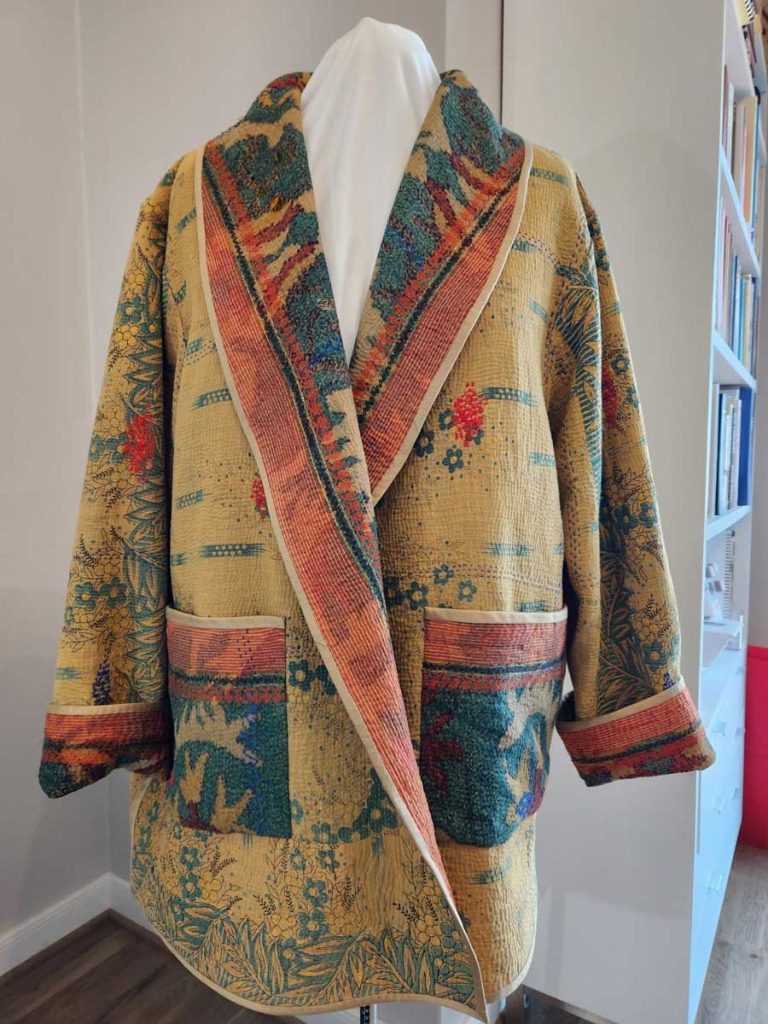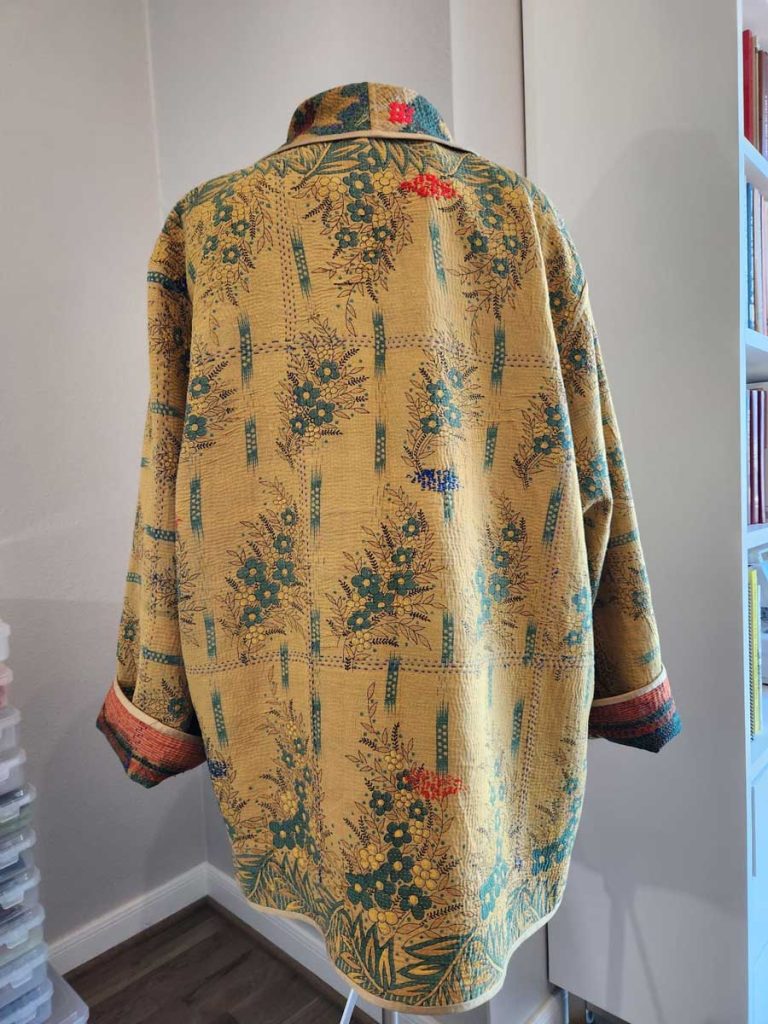
Some years ago, I wandered onto a website selling the beautiful clothing of designer Mieko Mintz. I was fascinated by her reversible patchwork jackets and vests. These colorful garments were crafted from fabric known as kantha. I wanted a kantha jacket—I was shocked by the prices, though. $1200 for a simple cotton jacket? As usual, I thought, “I can make one myself!”
Mieko’s website describes kantha as layers of old sari fabric hand-stitched together. This craft originated in Bengal, India.
Kantha were traditionally believed to protect users from harm and could help achieve happiness and prosperity. Some of the kantha designs appeared to be randomly patched scraps of fabric, and others seemed to be made of solid saris. They often have beautiful border designs that become focal points in Mieko Mintz’s garments. Mieko uses some vintage fabrics but also creates new fabrics for her clothing designs. [1]
Author Ekta Kaul describes kantha as a form of women’s art in India. Layers of old cloth, once used by family members, provide memories of loved ones. Women made kanthas in various sizes to celebrate rites of passage or to add beauty to their homes, much like our quiltmaker friends do. Today, kantha production has evolved into an industry in India, offering financial independence to many women. [2]
During a stroll through a Houston Heights antique mall a couple of years ago, I found a stack of kantha throws. “Get one,” my husband said. Don often aids and abets my sewing addiction. We selected a throw made of colorful silk fabrics. I took it home and draped it over a bench in my living room. It looked lovely there. Occasionally, I spread it out and tried to decide how I could cut the fabrics to create a pleasing arrangement for a jacket.

A few months later, the Marcy Tilton website offered several vintage kantha throws. I fell in love with one that had a border on all four edges and a beautiful color scheme. I ordered another kantha throw.

I searched for the perfect pattern. I wanted a reversible jacket with just a few seams. One night, while scrolling through Pinterest, I stumbled upon an out-of-print pattern for a reversible jacket. Vogue 2709 is a design by Koos Van Den Akker. Ignoring the appliques and chenille overlay, the pattern was perfect for my kantha jacket! I ordered the pattern from an Etsy dealer and it arrived a few days later.

Still, I hesitated to cut into the kantha throw. Upon receiving the notice about the ASG Houston 2025 fall luncheon and learning about the speaker, Bianca Springer, who creates garments from quilts, I was inspired to start working on my jacket!
I chose the throw I had purchased from Marcy Tilton because I thought the borders would complement the front and bottom edges of my jacket nicely. I spread the kantha throw on my dining table and experimented with different pattern placements. I was pleased to discover that there would be little fabric waste, but that meant that I had to lay out my pattern carefully. I was delighted to find a remnant of dupioni silk in my stash that was the perfect color to make the bindings. The jacket came together quickly, and I finished it in time to wear to the ASG luncheon. Now I am looking for ideas to sew up my other kantha throw. Maybe a long vest?

If you are interested in sewing with kantha fabric, there are some things to consider. If you purchase a “vintage” throw, your kantha may have worn spots. The throws are made from old fabric and may have endured daily use in a home. A vintage throw may require some mending or patching.
A vintage kantha throw might be dirty. Mine had a strong smell. It also had some worn spots, and I wondered whether to wash it myself or take it to the dry cleaner. My throw was made of cotton, and I guessed it had likely been washed many times. I decided to sew the jacket first. I hand-washed a scrap and saw that the water seemed very dirty. I decided to wash it on the delicate cycle with a gentle detergent in my washing machine. Then I air-dried it. A few spots showed slight fraying. I did some hand stitches to reinforce those areas, and I think my stitches blend in well with the original stitching.


If you would prefer to work with new kantha fabric, look for a kantha bedspread. Check the bed linen departments at major retail stores or look on Amazon or Etsy. I have also seen kantha by the yard on bolts at quilting shops. The fabric, stitching quality, and number of fabric layers will vary.
Some websites that sell Mieko Mintz’s clothing are listed below. These are great websites to gain design inspiration for other sewing projects as well.
By the way, I submitted photos of my kantha jacket to the Marcy Tilton blog (Marcy Tilton’s Blog for Everyday Creatives – Marcy Tilton Fabrics). Pictures of my jacket were included in her Sew &Tell – Summer Favorites, and I received a $50 gift card for March Tilton fabric!


Ekta Kaul’s book, Kantha: Sustainable Textiles and Mindful Making, describes the history and styles of kantha and illustrates many types of kantha stitches and embroidery used in the craft. She also introduces several textile artists who incorporate kantha in their work. There are pages and pages of beautiful photography.
[1] Mieko Mintz LLC (n.d.). Our Story. Mieko Mintz. Retrieved September 22, 2025, fromhttps://miekomintz.com/ [2] Kaul, E. (2024). Kantha: Sustainable Textiles and Mindful Making. Herbert Press, p.12-17.by Deborah Turkleson, ASG Member, Houston chapter





